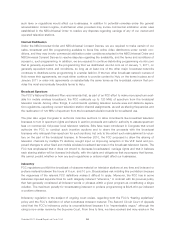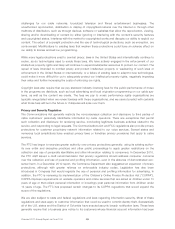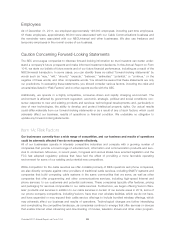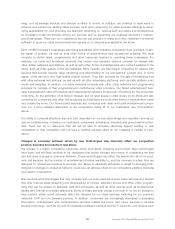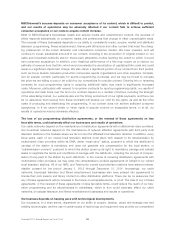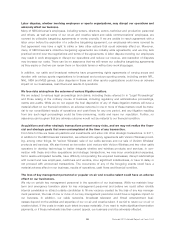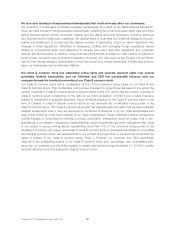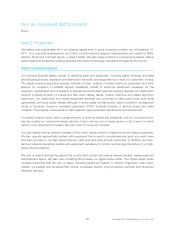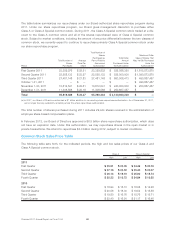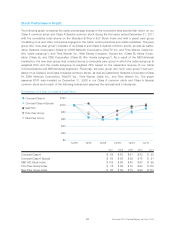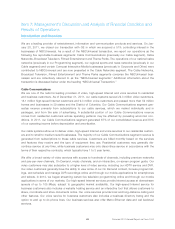Comcast 2011 Annual Report Download - page 35
Download and view the complete annual report
Please find page 35 of the 2011 Comcast annual report below. You can navigate through the pages in the report by either clicking on the pages listed below, or by using the keyword search tool below to find specific information within the annual report.with a competitive advantage. For example, while we are beginning to employ IP technology in certain of our
services, some phone companies have been using IP technology to provide video services in substantial por-
tions of their service areas, and wireless Internet technologies continue to evolve rapidly. We expect other
advances in communications technology to occur in the future. If we choose technology or equipment that is
not as effective, cost-efficient or attractive to consumers as that employed by our competitors, if we fail to
employ technologies desired by consumers before our competitors do so or if we fail to execute effectively on
our technology initiatives, our business and results of operations could be adversely affected. Moreover,
changes in the products and services that our competitors offer may require that we offer certain of our exist-
ing services or enhancements at a lower or no cost to our customers or that we make additional research
and development expenditures, which could have an adverse effect on our results of operations.
Our businesses depend on using and protecting certain intellectual property rights and on not infringing
the intellectual property rights of others.
We rely on our intellectual property, such as patents, copyrights, trademarks and trade secrets, as well as
licenses and other agreements with our vendors and other third parties, to use various technologies, conduct
our operations and sell our products and services. Legal challenges to our intellectual property rights and
claims of intellectual property infringement by third parties could require that we enter into royalty or licensing
agreements on unfavorable terms, incur substantial monetary liability or be enjoined preliminarily or perma-
nently from further use of the intellectual property in question or from the continuation of our businesses as
currently conducted, which could require us to change our business practices or limit our ability to compete
effectively and could have an adverse effect on our results of operations. Even if we believe any such chal-
lenges or claims are without merit, they can be time-consuming and costly to defend and divert
management’s attention and resources away from our businesses. Moreover, if we are unable to obtain or
continue to obtain licenses from our vendors and other third parties on reasonable terms, our business and
results of operations could be adversely affected.
In addition, intellectual property constitutes a significant part of the value of NBCUniversal’s businesses, and
our success is highly dependent on protecting intellectual property rights in the content we create or acquire
against third-party misappropriation, reproduction or infringement. The unauthorized reproduction, dis-
tribution or display of copyrighted material negatively affects our ability to generate revenue from the
legitimate sale of our content, as well as from the sale of advertising on our content, and increases our costs
due to our active enforcement of protecting our intellectual property rights. Piracy and other unauthorized
uses of content are made easier, and the enforcement of intellectual property rights more challenging, by
technological advances allowing the conversion of programming, films and other content into digital formats,
which facilitates the creation, transmission and sharing of high-quality unauthorized copies. In particular,
piracy of programming and films through unauthorized distribution on DVDs, peer-to-peer computer networks
and other platforms continues to present challenges for our cable networks, broadcast television and filmed
entertainment businesses. While piracy is a challenge in the United States, it is particularly prevalent in many
parts of the world that lack developed copyright laws, effective enforcement of copyright laws and technical
protective measures like those in effect in the United States. Any repeal or weakening of laws or enforcement
in the United States or internationally that is intended to combat piracy and protect intellectual property
rights, or a failure of the legal system to adapt to new technologies, could make it more difficult for us to
adequately protect our intellectual property rights, negatively impacting their value or increasing the costs of
enforcing our rights. See “Business – Legislation and Regulation – Other Areas of Regulation – Intellectual
Property” above for additional information.
Sales of DVDs have been declining.
Several factors, including weak economic conditions, the maturation of the standard-definition DVD format,
piracy and intense competition for consumer discretionary spending and leisure time, are contributing to an
33 Comcast 2011 Annual Report on Form 10-K



